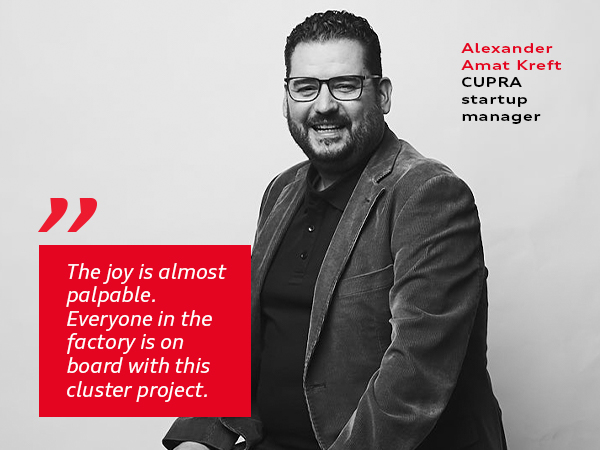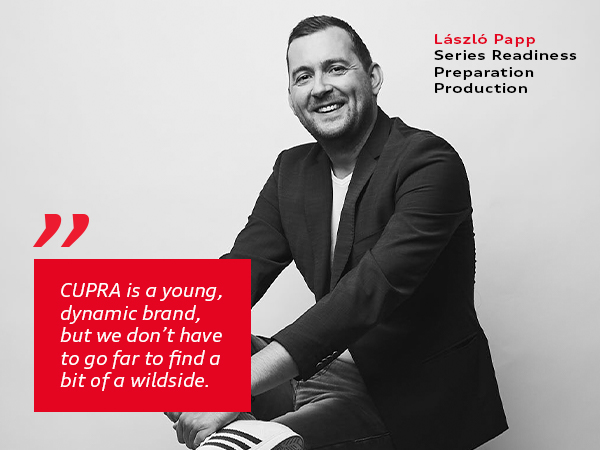
Vehicle production in Győr will soon be moving up a gear: from 2024, the cars of a new brand will be manufactured from start to finish at the Audi Hungaria plant. The preparations for making the Terramar, the new SUV model from the Spanish brand CUPRA are well underway. “A competent and extremely skilled team is working hard to ensure the project is completed according to schedule. We are delighted to be making the new CUPRA SUV model,” said Zoltán Les, member of the board of management for car production.
The CUPRA is a fresh and unique splash of colour among the Volkswagen Group’s upper mid-range brands. Though CUPRA was previously part of SEAT’s high-performance topof- the-range models, in 2018 it appeared on the market as an independent brand, further expanding the Volkswagen Group’s range and bringing a real Mediterranean feel to the category. Though engines produced in our Győr Engine Factory have already been used in CUPRA models, the future will see the synergies of the Volkswagen Group reach an even higher level – in addition to Audi models, we will also be making the CUPRATerramar at our Vehicle Factory from 2024. This will also improve the efficiency of the factory’s capacity utilisation, though, at Győr, we are already well-versed in this area: our Engine Factory produces power sources for a wide range of Audi, Volkswagen, Skoda, SEAT, CUPRA, Bentley and Lamborghini cars, while the Tool Factory manufactures body components for exclusive Volkswagen and Audi Group models.
The new CUPRA SUV model will be produced in Győr
with various forms of drive, including internal combustion engines
and plug-in hybrid technology.
HISTORICAL PARALLEL
The Terramar SUV model will serve as a connecting point between Audi and CUPRA – perhaps not surprisingly, given the similarities in the origin stories of the two brands. Founded in 1910, Audi suspended production after World War Two before being resurrected by the Volkswagen Group in the 1960s, with the four-ring brand positioned in the premium category. The rest of its story is well known, with Audi soon becoming a reference point for performance, design and comfort. CUPRA also began its existence as a higher category vehicle, and given the current momentum of its reception and sales, the Iberian brand can also look forward to a successful future.
We will manufacture the CUPRA Terramar with a range of engine options, including both internal combustion and plug-in hybrid technology, while CUPRA’s PHEV version will feature the next generation of plug-in hybrid technology. Planning has already begun: we will integrate the new CUPRA model into our existing production structure and exploit the synergies between products and technologies. Our Bodywork Factory is heavily involved in the preparations, with the first ‘Made in Győr’ CUPRA scheduled to roll off the production line in 2024.

Győr will be the first production site in the Audi Group to produce models from other brands. Within this process, I am responsible for the comprehensive introduction of the next generation of the CUPRA Terramar and the Audi Q3 and Q3 Sportback into series production. My team is working to ensure this is achieved in line with our objectives related to quality, quantity, costs and scheduling. We have to build the framework conditions and, where appropriate, adapt relevant processes so they are ready for the simultaneous production of multiple brands.
Both models will be based on the Volkswagen MQB platform. Both shared and Audi-specific components will be developed by Audi, while the CUPRA model’s own components will be developed by SEAT. The core processes have to meet the requirements of both brands, which is why we are working closely with theproject teams of Audi in Ingolstadt and CUPRA in Martorelli, while also keeping in touch with Volkswagen and IDG developers. The international work experience programme has been really beneficial for me, and I’m delighted to have the chance to coordinate such a multicultural team. As car models change rapidly, the preparations for production must also be continuously improved.
However, the fact that all of the participants in the project have plenty of experience and that everyone can now draw on our common knowledge is a really big help.

I have been working as the CUPRA Terramar startup manager in Győr since 1 July 2022. Before then, I spent two years at CARIAD, where I was involved in building our software company. For most of my career, however, I have worked on introducing new models to sites where several brands are produced. My first vehicle product of this kind was for the Q3 model, which had been produced at the SEAT Martorelli factory since 2011. When I found out we would be making a CUPRA model as well as the Q3 in Győr, I quickly made my decision – this was the place for me. It’s a great feeling to be working alongside my SEAT colleagues again after so many years. In that time, they have gained a lot of experience working on different projects at companies that produce several different brands simultaneously. We are now using this experienceto prepare the entire factory for the run-up to production.
Audi Hungaria has been preparing for this challenge for some time. When I arrived here, I was pleasantly surprised to see how well the preparations were going. The joy is almost palpable. Everyone in the factory is on board with this cluster project, and they can hardly wait to start making the models of the two brands together. Here, everyone is thinking in the right way – you can really feel the enthusiasm, which I quickly took on board myself, too. This is mainly thanks to the openness of my Hungarian colleagues. I’m really happy to have the chance to contribute to the success of this cluster project and use my experience to support Audi Hungaria. By producing the two brands on one site, we not only create additional synergies and significantly contribute to economising on the group’s operations, it also gives us a chance at Audi Hungaria to experience the true essence of our group.

I am responsible for coordinating and implementing the production of pre-series cars. Because this is the first time that another brand’s model will be manufactured at a production site belonging to the Audi Group, my main task is to search for synergies. Within the factory, we will examine the processes and identify which points need to be specially prepared to receive the production of the CUPRA Terramar, before establishing cooperation networks.
Because we have very well-practiced and well-established processes, we will be able to meet CUPRA’s expectations. In addition, during joint workshops with Spanish colleagues, it became clear that we have lots of similar processes. I also see similarities between the Spanish and Hungarian mentalities. I have encountered determined, challenge-seeking and really open-minded people, so we can expect a very productive partnership. I like the cluster approach, too, since the mechanisms and group dynamics are fundamentally designed to take into account the decisions related to both models, which is advantageous both technically and in terms of costs. CUPRA is a young, dynamic brand, but we don’t have to go far to find a bit of a wild side either: as a dynamic, cool car, the Audi TT made here shares many of the core CUPRA values. Because the TT has already travelled the same path in Győr, there should be no problem with integrating CUPRA – it will be a great fit for our portfolio.

I have been delegated to work in Ingolstadt since April 2021. As project leader, my main task is to prepare the Q3 and CUPRA models for bodywork processes, as well as to rebuild the Győr bodywork area in line with production requirements. I also bring together sub-projects that need to be implemented in the various production areas.
One fascinating thing about my work is that we are involving staff from another brand in the planning process for the first time. I have to adapt to new cultural environments, but the directness and openness of our Spanish colleagues is inspiring, and the general cooperation is excellent. This is very important to me, as there is plenty of work to do. In the bodywork area, we also have to protect the bodywork from corrosion. We have to coordinate the work methods, processes and needs of the two brands, something that involves a wide range of smaller details. One example: there are no aluminium bodywork parts in the CUPRA Terramar model, but the high proportion of matt surfaces used by the Spanish brand is new to us. As a result, I have been coordinating a team to examine the effects and redevelopment requirements so we can meet the increased demand for matt finishes in the future. We have also contacted Lamborghini in Italy to learn more about the working methods for sports car production.
